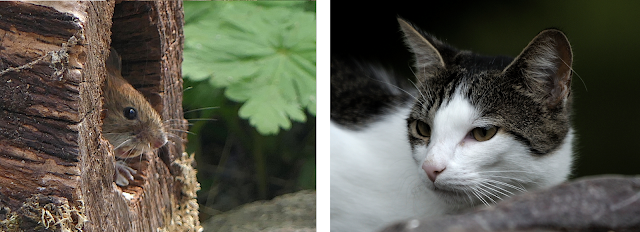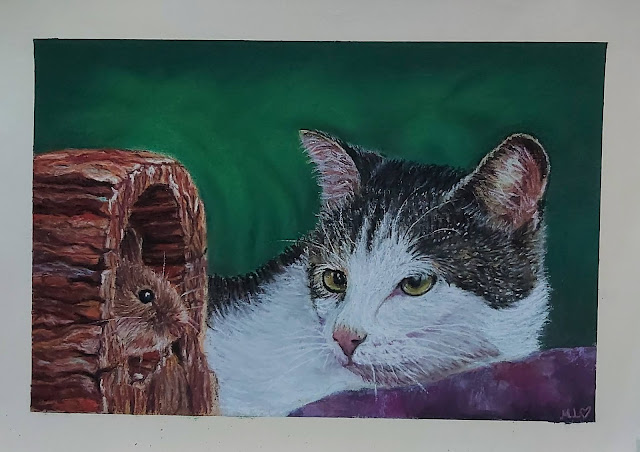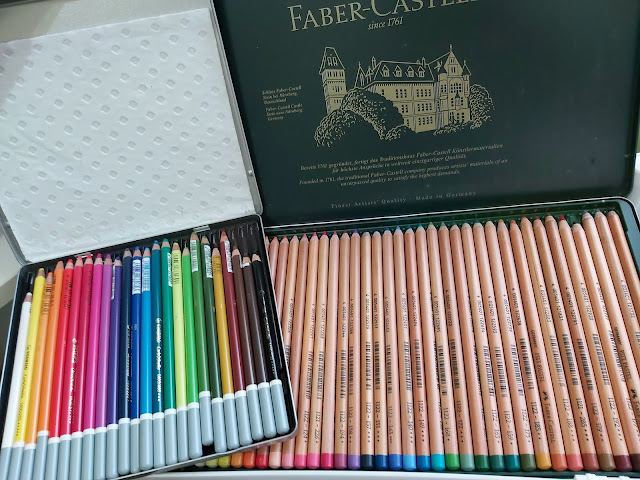Hide and Seek on homemade pastel paper
The website Paint My Photo, where artists can access copyright-free photos to paint, holds a monthly challenge for artists. November's challenge is entitled "Partners", meaning a drawing depicting two typical partner words, eg. lock and key. Photo references have to be from the website.
Intrigued, I thought I would try out, so over the past two days, I painted this. Clearly, the partner words are "cat and mouse" but I named it Hide and Seek.
It's a combination of two photos, I thought they fit perfectly together.
 |
| Photos: Thomas Habermann and Aschi |
Here's how I painted this picture. First, the background - a layer of Panpastels.
Then add soft pastels and blend it all in. I used mostly Sennelier and Mungyo handmade pastels as I have a good selection of greens in these. A lot of pastel dust was created, so I decided to spray a layer of fixative to set that area. What that did was spread a fine mist of green pastel dust all over the cat and mouse. Just great.
Anyway, I continued with the log and the mouse. I wanted to infuse the log with colour, but I didn't go far enough so it just looks like a very, very bright log.
 |
Finished up the mouse and on to the cat. Panpastels first once again.
Cat done, after a lot of layering of the white to try and cover that darn green speckle. And then it's just that log under the cat left, which I decided on a whim to colour purple, so it now looks like some marble thingy. Ah well.
This drawing was fun but it was a little frustrating as well. The reason was that I was working on homemade pastel paper. I was very excited when I found out that Art Spectrum sold a pastel primer called Colourfix which you could paint on regular paper and create paper with "tooth" that works like sanded paper. If you don't already know, pastels work best on sanded paper but ready-made sanded paper is crazy expensive - as much as 10 times more expensive than regular art paper. If this was a way to save some money, I was all ears!
I had bought a jar of Colorrfix in the shade Sand, which is a creamy yellow hue.
It seems easy enough. The consistency is just right, not too thick or thin. No need to add water, you just paint it on.
I painted three different typcs of paper, to see if there was a difference. They are (left to right): Canson Bristol paper 224gsm, Canson Bristol Extra Smooth 250gsm and Canson Watercolor Paper 300gsm. They recommend using at least 300gsm paper to prevent warping.
All of them warped slightly but my problem wasn't the warping. The problem I found was that it was pretty much impossible to paint an even surface. No matter what I tried - taping the paper down, using just one thin coat, painting slowly in the same direction, nothing worked. The surfaces ended up with uneven bumps and left some empty patches. (This was the first batch, I've since done another batch - same issues).
Hide and Seek is the third drawing I tried on this pastel paper and the experience is the same regardless of which paper I used. It's like trying to draw on gravelly road. You keep going over road bumps or potholes which makes getting fine details next to impossible. I tried to make this painting work by using mostly soft pastels. Soft pastels work the best on this paper, at least you can get some marks on it. For whatever reason, this paper hates pastel pencils. They go on thin and scratchy and I have to press very hard to make marks on it.
My personal opinion is that Colourfix pastel primer doesn't even come close to a good alternative for sanded paper, which is such a bummer. It's not the same as the Art Spectrum Colourfix pastel paper, even though that's supposedly made with this primer.
However, I speak as someone who likes to paint details, since I draw a lot of animal portraits. It might work for you if you like painting landscapes in an Impressionistic or painterly style, using broad strokes with very soft pastels. The soft pastels I used on the log turned out ok.
This is just my personal opinion, of course, but between the pastel primer paper and unsanded paper, I'd rather use unsanded paper. These are my preferred unsanded papers for pastels.












Comments
Post a Comment